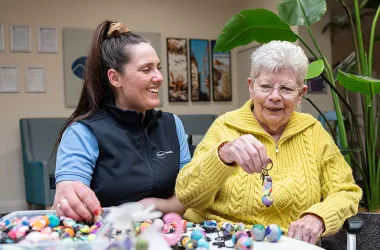Tips for moving into residential care
12th December 2022 | 3 min read
Moving house is known to be one of life’s biggest stressors – no matter what age or stage we’re at. Moving into residential care is no different. Fortunately, there are ways to help make the transition as smooth as possible for your loved one.
Carryn, General Manager at Geraldton Shore Care Community, has worked in residential aged care for over 30 years.
"We all deserve to live in a place where we feel safe and secure," says Carryn.
“For many family members and friends, the journey into care can be a rollercoaster of emotions, alternating between loss and guilt on some days and relief and gratitude on others.
“A little bit of planning can make a world of difference.”
5 steps for a smooth transition into care:
1. Visit the Care Community before you move in
Get a good sense of the Care Community and room layout by visiting ahead of time with your loved one (if their health allows).
“Talk with our team or even share a meal with other residents”, says Carryn.
“As you look around, try visualising how you could make the space feel like home to your loved one, so you can help decide what to bring.”
2. Get any paperwork out of the way
If possible, try to get paperwork signed before moving in, so that move-in day can be all about helping your loved one settle in.
“It’s especially important to consider whether a trusted family member or friend has been identified to help them manage their affairs and make health, medical and lifestyle decisions, in case they’re no longer able to do this for themselves”, says Carryn.
“Our team can also provide information about power of attorney or enduring guardian matters.”
3. Personalise your space
We all feel better when we’re surrounded by things that are familiar and special – things that bring us joy.
“Your bedroom is your most intimate place of comfort and belonging. Help your loved one select things from home to bring with them that will help make their new room feel like home,” says Carryn.
Small furniture items, photographs in frames, posters, pictures, certificates and awards that remind you of special places, times, images and achievements are a great way to personalise your space, feel a sense of ownership, and share some of your life, personality and passions.
4. Focus on the positive
Help your loved one to focus on what they’ll gain in care rather than on any perceived loss.
“Aged care can be a very positive move. A time to enjoy companionship and have valuable support with daily living,” Carryn says.
“Try to emphasise the positives. Having time to pursue personal interests. Gardening or growing vegies.
Socialising with others. Not having to cook every day! Living in care can help people focus on reablement and revive passions and pastimes.”
5. Take your time
Moving into care can be an emotional time for everyone involved.
“Try not to judge or rush”, Carryn says. “Just make yourself available to listen and be a compassionate ear for any concerns or anxieties.”
Spend time helping your loved one identify enjoyable activities or coming up with a satisfying new routine.
“Remind them that they’re loved and that you’ll continue to call or visit.”
Our team can help you get a sense of what the first few days will be like and what decisions to consider. For example: would your loved one prefer to have their first meal in the dining room with you, with residents who may share their interests, or have in-room dining while they settle in?
You’re welcome to talk with one of our team.
More from our Care Communities

News & Events
Highgate Park update
19th December 2025 | 2 min read

Care Community stories
Sicilian connections at Glenroy Grove
16th December 2025 | 4 min read

Care Community stories
Purpose with Parkinson's Disease
12th December 2025 | 4 min read